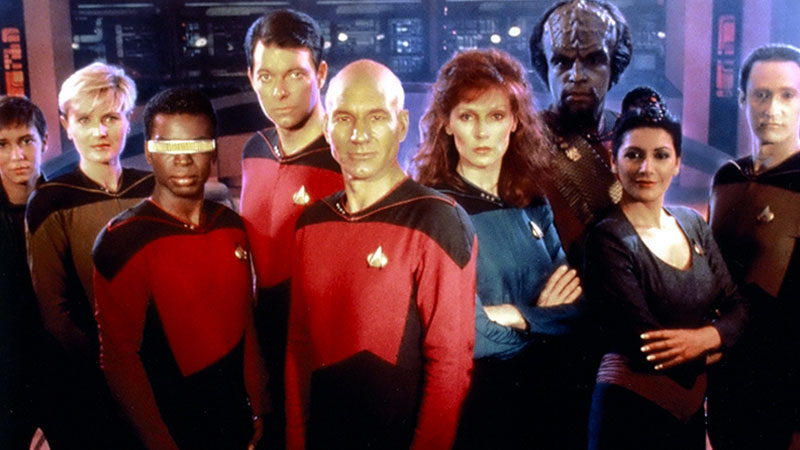The week of September 24, 2017 saw two major events in the Star Trek universe: the debut of a brand new Star Trek television series after a 12-year absence from the small screen, and the 30th Anniversary of Star Trek: The Next Generation. Star Trek: Discovery launched after numerous delays and a great deal of trepidation to decidedly mixed reviews: Many fans loved it and the bold way that it moves the franchise forward. Others, though, have not been as kind. With the debut of the first two episodes of the series, the reactions have ranged from praise to outright hostility. Many fans hate the way that the Klingons have been redesigned. Others are opposed to having a show that’s set 10 years prior to the time of Kirk and Spock sporting special effects and depictions of technology far in advance of what we saw in The Original Series. Why do a prequel at all when it’s going to look incongruous, to say the least, set between Enterprise and TOS? And the biggest point of consternation of all: that CBS is delivering the show on its new streaming service All Access rather than on broadcast. Debuting the week of the 30th Anniversary of Star Trek: The Next Generation makes for an interesting study, as the new show is starting out at a similar trajectory.
TNG: widely viewed as the greatest Star Trek series, the flagship of the franchise, the jewel in the crown. It boasts some of the greatest-ever episodes in the history of the franchise, and its characters are loved in a special way. It’s frequently is listed in the Top 5 best science fiction shows of all time. But that’s not how the story began. I think that people tend to forget that Star Trek: The Next Generation didn’t start life as a fan favorite; it faced just as much opposition in its day as Star Trek: Discovery is now. People hated the idea of a Klingon as part of a Federation crew. That a blind guy was piloting the ship (Geordi LaForge, before suddenly becoming the ship’s chief engineer in Season Two, was the navigator) was ridiculed. Many people hated the ship design: the deflector dish on the front of the ship looked like a big target, and the bridge looked like a hotel lobby. The counselor in the cheerleader outfit who reacted to everyone else’s emotions was the butt of many jokes (and why was the counselor on the bridge, anyway?). And in response to Patrick Stewart’s casting, the tagline “to baldly go” was coined by fans long before the first episode aired. And wow, people were furious about a starship that carried families!

TNG‘s first season wasn’t all that well-received at first, hampered by episodes that were seen as ripoffs of TOS episodes, writers quitting mid-season over disputes with Gene Roddenberry, one actor quitting before the season was done (Lt. Tasha Yar became the first Star Trek main cast character to be killed off), etc. But things started to pick up in the second half of the season, and the show scored some genuine hits: “The Big Goodbye” was nominated for numerous awards and won a Peabody; “Heart of Glory” gave us our first clues of how TNG would flesh out and develop the Klingon culture; “The Arsenal of Freedom” demonstrated that this show had a strong ensemble cast as every character got used in an interesting way that was vital to the plot; and “Conspiracy” presented the intriguing possibility of alien infiltration at the highest levels of Starfleet and set up a thrilling story thread for future seasons (which, sadly, was never addressed again).
Season Two was equally rocky, with cast changes (introducing veteran TOS guest-star Diana Muldaur as Dr. Katherine Pulaski), writers’ strikes and budgetary woes. Still, the season delivered a few strong scripts, the most important being “Measure of a Man,” in which Data is put on trial to determine his status as either sentient individual or property. It was a powerful episode, smartly written and well acted, and it the first time the show truly demonstrated the heights to which it would eventually soar. In spite of that, after a delayed start due to the strike, Season Two limped to the finish line, out of money, with a cheaply-produced clip show. Not Trek‘s finest hour.
It was Season Three, though, where everything changed. Dr. Crusher was back. The uniforms were redesigned. The sets were lit differently. Everything looked different. The music was less cheesy. The episodes were challenging and more solidly written (due in large part to new head writer Michael Piller’s changes to the script submission policy). There was a confidence about the production that permeated every aspect of it. We saw the main characters developed in new and exciting ways. And there were some amazing episodes – like “The Bonding,” “The Defector” (the Romulans played a much more prominent role in the series during the this period), “Sins of the Father” (where the ongoing saga of Klingon civil war and the role of Worf’s family honor heats up),”Captain’s Holiday,” “Hollow Pursuits,” and “Sarek” (with the return of Mark Lenard and that amazing scene at the end that allowed Patrick Stewart to really show us what calibre of actor he is). But it was “Yesterday’s Enterprise” – right in the middle of the season – that propelled TNG to new heights. The tale of an alternate reality in which the Federation is losing a war with the Klingons because the Enterprise 1701-C is taken out of time, it’s a daring examination of how wartime affects the show’s core characters and the Federation’s principles.

To cap off an extraordinary year, Season Three had one final trick up its sleeve: a cliffhanger ending. Star Trek had only ever done one 2-parter (“The Menagerie,” a TOS first season double episode written to utilize the footage from the show’s original unaired pilot, “The Cage”), and never at the end of a season, so this was something completely unexpected. In “The Best of Both Worlds,” Picard is captured by the Borg and assimilated. I recall in vivid detail watching the clock on the wall tick down to the end of the hour and Picard still hadn’t been rescued! How were they possibly going to resolve this in 60 seconds? 45 seconds? 30 SECONDS?? With guns trained on the Borg ship, the camera closes in on Riker’s face, and he says “Mr. Worf . . . fire.” The picture fades to black with the words “To Be Continued” emblazoned on the screen. WHAT??? Nothing like this had ever happened in Trek before! It was the most exciting moment to ever happen in Star Trek up to that point. And it got people talking. This was Star Trek: The Next Generation firing on all cylinders.
But it wasn’t simply that cliffhanger, or the encounter with the Borg, that made this episode so special. There were great character moments as well, particularly between Riker and the young, gung-ho, ambitious Lt. Commander Shelby, who made no secret that she was gunning for Riker’s job. But that’s really the secret to TNG‘s success: Characters. It wasn’t simply the excellent writing, the inventive storytelling, the continuation of a beloved franchise. It was the characters. It was Riker, the charming first officer who had a passion for jazz and poker. It was Worf, the Klingon raised by humans, caught in a constant internal (and occasionally external) cultural war. It was Data, the android who was fascinated by human behavior and strove to achieve some semblance of humanity. It was Geordi LaForge, the brilliant engineer who was completely hapless when it came to dating and who became Data’s best friend. It was Troi, with the overbearing mother and the love of chocolate. And, of course, it was Picard, the gentleman captain, who preferred diplomacy and negotiation over a firefight. It was the relationships that developed between these people, the care that they showed for each other. That’s why TNG became the hit that it did. That’s why audiences enlisted each week to join the good ship Enterprise and her crew on their continuing mission.

Star Trek: Discovery has just left drydock and still has a lot of travels ahead of it. It’s facing many of the challenges that Star Trek: The Next Generation did when it first launched. But if it can establish characters that audiences identify with and enjoy spending time with, and that form the kinds of relationships that the TNG crew did, then coupled with compelling storytelling it’ll do just fine. It just has to get through its shakedown cruise. It took some time, but The Next Generation did. And Discovery will too.
